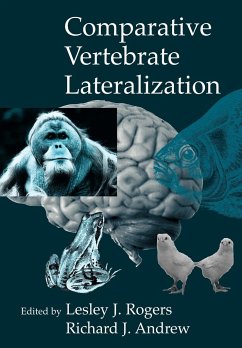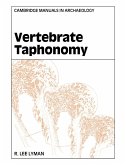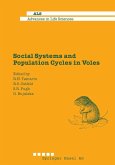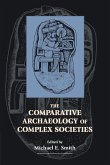Comparative Vertebrate Lateralization
Herausgeber: Rogers, Lesley J.; Andrew, Richard John
Comparative Vertebrate Lateralization
Herausgeber: Rogers, Lesley J.; Andrew, Richard John
- Broschiertes Buch
- Merkliste
- Auf die Merkliste
- Bewerten Bewerten
- Teilen
- Produkt teilen
- Produkterinnerung
- Produkterinnerung
Compares brain lateralization among lower vertebrates, birds, nonprimate mammals and primates, including humans.
Andere Kunden interessierten sich auch für
![Comparative Vertebrate Endocrinology Comparative Vertebrate Endocrinology]() Peter J. BentleyComparative Vertebrate Endocrinology120,99 €
Peter J. BentleyComparative Vertebrate Endocrinology120,99 €![Vertebrate Taphonomy Vertebrate Taphonomy]() Cma LymanVertebrate Taphonomy92,99 €
Cma LymanVertebrate Taphonomy92,99 €![Fertilization and Embryonic Development In Vitro Fertilization and Embryonic Development In Vitro]() Luigi MastroianniFertilization and Embryonic Development In Vitro41,99 €
Luigi MastroianniFertilization and Embryonic Development In Vitro41,99 €![Social Systems and Population Cycles in Voles Social Systems and Population Cycles in Voles]() R. TamarinSocial Systems and Population Cycles in Voles41,99 €
R. TamarinSocial Systems and Population Cycles in Voles41,99 €![Comparative Historical Analysis in the Social Sciences Comparative Historical Analysis in the Social Sciences]() James Mahoney / Dietrich Rueschemeyer (eds.)Comparative Historical Analysis in the Social Sciences29,99 €
James Mahoney / Dietrich Rueschemeyer (eds.)Comparative Historical Analysis in the Social Sciences29,99 €![Advances in Comparative-Historical Analysis Advances in Comparative-Historical Analysis]() Advances in Comparative-Historical Analysis109,99 €
Advances in Comparative-Historical Analysis109,99 €![The Comparative Archaeology of Complex Societies The Comparative Archaeology of Complex Societies]() The Comparative Archaeology of Complex Societies43,99 €
The Comparative Archaeology of Complex Societies43,99 €-
-
-
Compares brain lateralization among lower vertebrates, birds, nonprimate mammals and primates, including humans.
Hinweis: Dieser Artikel kann nur an eine deutsche Lieferadresse ausgeliefert werden.
Hinweis: Dieser Artikel kann nur an eine deutsche Lieferadresse ausgeliefert werden.
Produktdetails
- Produktdetails
- Verlag: Cambridge University Press
- Seitenzahl: 672
- Erscheinungstermin: 31. Mai 2008
- Englisch
- Abmessung: 244mm x 170mm x 36mm
- Gewicht: 1140g
- ISBN-13: 9780521787000
- ISBN-10: 0521787009
- Artikelnr.: 24550191
- Herstellerkennzeichnung
- Libri GmbH
- Europaallee 1
- 36244 Bad Hersfeld
- gpsr@libri.de
- Verlag: Cambridge University Press
- Seitenzahl: 672
- Erscheinungstermin: 31. Mai 2008
- Englisch
- Abmessung: 244mm x 170mm x 36mm
- Gewicht: 1140g
- ISBN-13: 9780521787000
- ISBN-10: 0521787009
- Artikelnr.: 24550191
- Herstellerkennzeichnung
- Libri GmbH
- Europaallee 1
- 36244 Bad Hersfeld
- gpsr@libri.de
Preface; Introduction; Part I. Evolution of Lateralization: 1. How ancient
is lateralization? G. Vallortigara and A. Bisazza; 2. The earliest origins
and subsequent evolution of lateralization R. J. Andrew; 3. The nature of
lateralization in tetrapods R. J. Andrew and L. J. Rogers; 4. Advantages
and disadvantages of lateralization L. J. Rogers; Part II. Development of
Lateralization: 5. Behavioral development and lateralization R. J. Andrew;
6. Factors affecting the development of lateralization in chicks C. Deng
and L. J. Rogers; 7. Ontogony of visual lateralization in pigeons O.
Güntürkün; 8. Development of laterality and the role of the corpus callosum
in rodents and humans P. E. Cowell and V. H. Denenberg; 9. Posture and
laterality in human and nonhuman primates: asymmetries in maternal handling
and the infant's early motor asymmetries E. Damerose and J. Vauclair; Part
III. Cognition and Lateralization: 10. Evidence of cerebral lateralization
from senses other than vision R. J. Andrew and J. A. S. Watkins; 11. Facing
an obstacle: lateralization of object and spatial cognition G. Vallortigara
and L. Regolin; 12. Laterality of communicative behaviors in nonhuman
primates: a critical analysis W. D. Hopkins and S. F. Carriba; 13.
Specialized processing of primate facial and vocal expressions: evidence
for cerebral asymmetries D. J. Weiss, A. A. Ghazanfar, C. T. Miller and M.
D. Hauser; Part IV. Lateralization and Memory: 14. Memory and lateralized
recall A. N. B. Johnston and S. P. R. Rose; 15. Memory formation and brain
lateralization R. J. Andrew; Epilogue; Appendix; Index.
is lateralization? G. Vallortigara and A. Bisazza; 2. The earliest origins
and subsequent evolution of lateralization R. J. Andrew; 3. The nature of
lateralization in tetrapods R. J. Andrew and L. J. Rogers; 4. Advantages
and disadvantages of lateralization L. J. Rogers; Part II. Development of
Lateralization: 5. Behavioral development and lateralization R. J. Andrew;
6. Factors affecting the development of lateralization in chicks C. Deng
and L. J. Rogers; 7. Ontogony of visual lateralization in pigeons O.
Güntürkün; 8. Development of laterality and the role of the corpus callosum
in rodents and humans P. E. Cowell and V. H. Denenberg; 9. Posture and
laterality in human and nonhuman primates: asymmetries in maternal handling
and the infant's early motor asymmetries E. Damerose and J. Vauclair; Part
III. Cognition and Lateralization: 10. Evidence of cerebral lateralization
from senses other than vision R. J. Andrew and J. A. S. Watkins; 11. Facing
an obstacle: lateralization of object and spatial cognition G. Vallortigara
and L. Regolin; 12. Laterality of communicative behaviors in nonhuman
primates: a critical analysis W. D. Hopkins and S. F. Carriba; 13.
Specialized processing of primate facial and vocal expressions: evidence
for cerebral asymmetries D. J. Weiss, A. A. Ghazanfar, C. T. Miller and M.
D. Hauser; Part IV. Lateralization and Memory: 14. Memory and lateralized
recall A. N. B. Johnston and S. P. R. Rose; 15. Memory formation and brain
lateralization R. J. Andrew; Epilogue; Appendix; Index.
Preface; Introduction; Part I. Evolution of Lateralization: 1. How ancient
is lateralization? G. Vallortigara and A. Bisazza; 2. The earliest origins
and subsequent evolution of lateralization R. J. Andrew; 3. The nature of
lateralization in tetrapods R. J. Andrew and L. J. Rogers; 4. Advantages
and disadvantages of lateralization L. J. Rogers; Part II. Development of
Lateralization: 5. Behavioral development and lateralization R. J. Andrew;
6. Factors affecting the development of lateralization in chicks C. Deng
and L. J. Rogers; 7. Ontogony of visual lateralization in pigeons O.
Güntürkün; 8. Development of laterality and the role of the corpus callosum
in rodents and humans P. E. Cowell and V. H. Denenberg; 9. Posture and
laterality in human and nonhuman primates: asymmetries in maternal handling
and the infant's early motor asymmetries E. Damerose and J. Vauclair; Part
III. Cognition and Lateralization: 10. Evidence of cerebral lateralization
from senses other than vision R. J. Andrew and J. A. S. Watkins; 11. Facing
an obstacle: lateralization of object and spatial cognition G. Vallortigara
and L. Regolin; 12. Laterality of communicative behaviors in nonhuman
primates: a critical analysis W. D. Hopkins and S. F. Carriba; 13.
Specialized processing of primate facial and vocal expressions: evidence
for cerebral asymmetries D. J. Weiss, A. A. Ghazanfar, C. T. Miller and M.
D. Hauser; Part IV. Lateralization and Memory: 14. Memory and lateralized
recall A. N. B. Johnston and S. P. R. Rose; 15. Memory formation and brain
lateralization R. J. Andrew; Epilogue; Appendix; Index.
is lateralization? G. Vallortigara and A. Bisazza; 2. The earliest origins
and subsequent evolution of lateralization R. J. Andrew; 3. The nature of
lateralization in tetrapods R. J. Andrew and L. J. Rogers; 4. Advantages
and disadvantages of lateralization L. J. Rogers; Part II. Development of
Lateralization: 5. Behavioral development and lateralization R. J. Andrew;
6. Factors affecting the development of lateralization in chicks C. Deng
and L. J. Rogers; 7. Ontogony of visual lateralization in pigeons O.
Güntürkün; 8. Development of laterality and the role of the corpus callosum
in rodents and humans P. E. Cowell and V. H. Denenberg; 9. Posture and
laterality in human and nonhuman primates: asymmetries in maternal handling
and the infant's early motor asymmetries E. Damerose and J. Vauclair; Part
III. Cognition and Lateralization: 10. Evidence of cerebral lateralization
from senses other than vision R. J. Andrew and J. A. S. Watkins; 11. Facing
an obstacle: lateralization of object and spatial cognition G. Vallortigara
and L. Regolin; 12. Laterality of communicative behaviors in nonhuman
primates: a critical analysis W. D. Hopkins and S. F. Carriba; 13.
Specialized processing of primate facial and vocal expressions: evidence
for cerebral asymmetries D. J. Weiss, A. A. Ghazanfar, C. T. Miller and M.
D. Hauser; Part IV. Lateralization and Memory: 14. Memory and lateralized
recall A. N. B. Johnston and S. P. R. Rose; 15. Memory formation and brain
lateralization R. J. Andrew; Epilogue; Appendix; Index.








